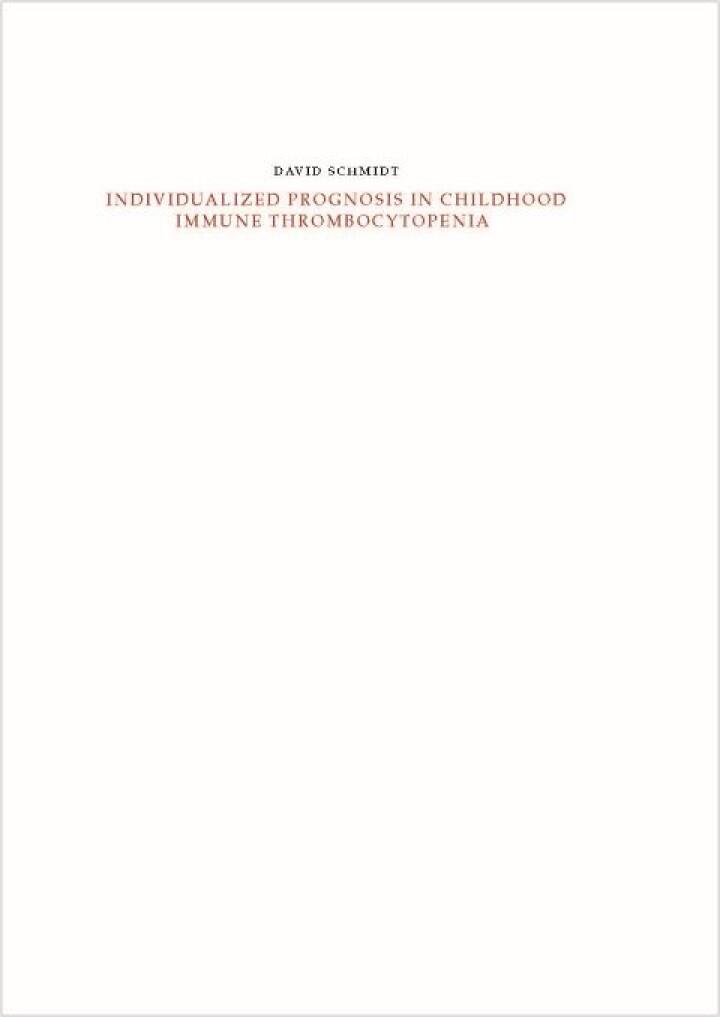Thesis David Schmidt
On 7 April 2022 (13:45) Sanquin researcher David Schmidt defended his thesis 'Individualized Prognosis in Childhood Immune Thrombocytopenia' at Leiden University.
Promotor: Prof M de Haas MD PhD
Copromotor: MCA Bruin MD PhD and G Vidarsson PhD
Venue: Academy Building, Leiden University and online
Summary
Childhood immune thrombocytopenia (ITP) is an acquired autoimmune disease with humoral and cellular immune reactions against platelet self-antigens. ITP results in a bleeding tendency of varying severity, and leads to an impaired quality of life. The clinical course ranges from self-limiting (recovery within a few months after diagnosis) to development of chronic disease, lasting for minimally one year. It is a rare disease, which occurs in about 2-6 per 100,000 children annually. Although ITP occurs at any age, it is observed more frequently in children younger than six years. A key challenge is identifying a child’s disease course at the time of diagnosis. This may help to determine optimal clinical management, including whether to start treatment versus watchful waiting, the timing of additional diagnostic tests, and to counsel families appropriately.
In his research, David focused on possibilities to determine and explain prognosis of disease course in childhood ITP, at the time of diagnosis. He investigated if he could identify known or novel molecular markers, such as antibody characteristics and genotypes and immune markers, as prognostic factors in childhood ITP. He used clinical and molecular data from our Dutch large multicenter randomized clinical trial in childhood ITP (TIKI trial) in computational approaches for different prediction models. He initiated an international collaboration to validate a new clinical prediction score and made it available for use for treating physicians.
David performed his research at Sanquin both in the group of Gestur Vidarsson at the Dept of Experimental Immunohematology in collaboration with Ellen van der Schoot; in the group of Masja de Haas in collaboration with Leendert Porcelijn at Immunohematology Diagnostics and with Anske van der Bom at the Center for Clinical Transfusion Research and Clinical Epidemiology of LUMC; all in close collaboration with Marrie Bruin and Katja Heitink-Pollé, both pediatrician haematologists at the Princess Maxima Center, Utrecht. Since 2020, David continued his training as specialist in pediatrics at the Astrid Lindgren Childrens Hospital, at the Karolinksa University Hospital, In Sweden.
Chapters
i Introduction
Chapter 1
Childhood Immune Thrombocytopenia
1.1 Morbidity and mortality
1.2 Disease mechanisms
1.3 Diagnosis
1.4 Prognosis
1.5 Clinical management
1.6 Treatment options
1.7 Modification of ITP disease courses
1.8 Towards individualized prognosis and treatment
1.8.1 Proposed prediction markers of ITP disease courses
1.9 Statistical learning
1.10 Research questions and scope of the thesis
ii Genetic and immune parameters for prognosis
Chapter 2
Age at diagnosis shapes the prognosis of childhood ITP medRxiv
Chapter 3
Transient and chronic childhood immune thrombocytopenia are distinctly affected by Fc-g receptor polymorphisms abstract
Chapter 4
Platelet autoantibody immunoassays in childhood ITP: a systematic review abstract
Chapter 5
Antigen-specific autoantibodies indicate prognosis and IVIg treatment response in childhood immune thrombocytopenia abstract
Chapter 6
ITGB1-expressing CD4+ T effector cell response associates with chronic childhood immune thrombocytopenia
iii Pathophysiology and mechanisms of ITP
Chapter 7
IgG-Fc glycosylation before and after rituximab treatment in immune thrombocytopenia abstract
Chapter 8
Anti-glycoprotein Iba autoantibodies do not impair circulating thrombopoietin levels in immune thrombocytopenia patients abstract
iv Models for prognostication
Chapter 9
A clinical prediction score for transient versus persistent childhood immune thrombocytopenia
Chapter 10
Biological stratification of clinical disease courses in childhood immune thrombocytopenia
Chapter 11
Intravenous Immunoglobulins (IVIg) in childhood immune thrombocytopenia: towards personalized medicine abstract
v Discussion
Chapter 12
General discussion
12.1 Prediction models for ITP prognosis
12.1.1 Individualized prediction of ITP spontaneous recovery and IVIg treatment responses
12.2 Insights into ITP pathophysiology
12.2.1 Genetic heterogeneity
12.2.2 Platelet autoantibodies
12.2.3 Cellular immune response
12.2.4 Age heterogeneity
12.2.5 Further thoughts on mechanisms
12.3 Clinical implications
12.3.1 Diagnosis of ITP
12.3.2 Prognosis versus diagnosis
12.3.3 Additional diagnostic tests
12.3.4 Treatment
12.3.5 Questions of generalizability
12.3.6 Follow-up studies
12.4 A roadmap to advance ITP research & care
12.4.1 Dogmalysis
12.4.2 Better clinical study design
12.4.3 Focus on patient-centered outcomes
12.4.4 Towards a reporting standard
Chapter 13
Conclusions
Download
Download PhD thesis (university repository)
